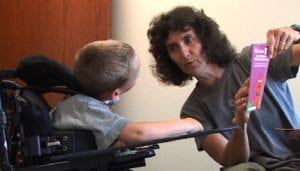 The AAC Learning Center hosts a wide variety of webcasts by AAC researchers, and co-presentations with people who use AAC.
The AAC Learning Center hosts a wide variety of webcasts by AAC researchers, and co-presentations with people who use AAC.
Research to Practice
- Maximizing the literacy skills of individuals who require AAC (quiz available)
Janice Light, PhD - AAC interventions to maximize language development for young children (quiz available)
Janice Light - Successful Employment for Individuals who use AAC (quiz available)
David McNaughton, PhD, & Anthony Arnold - AAC for Persons with Primary Progressive Aphasia
Melanie Fried-Oken, PhD - Supporting Communication of Individuals with Minimal Movement (quiz available)
Susan Fager, PhD & David Beukelman, PhD - AAC for Aphasia: A Review of Visual Scenes Display Project
David Beukelman, PhD, Karen Hux, Ph.D., Kristy Weissling, MA, Aimee Dietz, MS, Miechelle McKelvey, MA, - Visual Immersion Program for persons with autism
Howard Shane, PhD & Meghan O’Brien, MA - Public school students: Who can pay for SGDs?
Lew Golinker, Esq. - Mobile devices and communication Apps: Current trends and future directions
David McNaughton, Ph.D., Howard Shane, Ph.D., Jessica Gosnell, MA, & Sam Sennott, Ph.D. - Seating and positioning for people who use AAC
Aileen Costigan, MSc-OT - Introduction to AAC
Kathy Drager, Ph.D., Janice Light, Ph.D., & David McNaughton, Ph.D. - Improving literacy outcomes for individuals with ASD and limited speech
Janice Light, Ph.D., & David McNaughton, Ph.D. - Language and Learning: Cognitive Science Considerations in the Design of AAC Technologies
Janice Light, Ph.D., & Melanie Fried-Oken, Ph.D. - Patient Provider Communication
Sarah Blackstone, Ph.D. et al - Adaptive Access: Key Design Considerations
Susan Fager, PhD & Jeff Higginbotham, PhD - AAC and Communication in the Workplace
David Chapple and David McNaughton, Ph.D. - Bridging Research to Practice with Visual Scene Displays (VSDs)
Christine Holyfield, Ph.D., Michelle Therrien, Ph.D., Emily Laubscher, Nimisha Muttiah, Ph.D., Jessica Caron, Ph.D., Salena Babb, Ph.D.